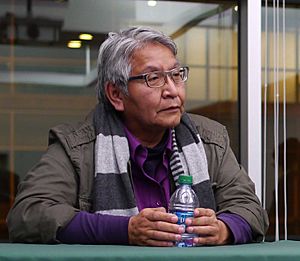Hulleah Tsinhnahjinnie facts for kids
Quick facts for kids
Hulleah Tsinhnahjinnie
|
|
|---|---|

Tsinhnahjinnie at a panel in 2015 in San Francisco, California
|
|
| Born | August 26, 1954 |
| Nationality | American and Navajo Nation |
| Education | Institute of American Indian Arts |
| Alma mater | California College of the Arts University of California, Irvine |
| Occupation | photographer, museum director, curator, professor |
| Employer | University of California, Davis, C.N. Gorman Museum |
| Known for | photography, videography |
|
Works
|
Mattie Goes Traveling, Mattie Looks for Steven Biko, Grandma and Me, Aboriginal World View |
| Awards | Eiteljorg Fellowship for Native American Fine Art, Chancellor's Fellowship at the University of California Irvine, First Peoples Community Artist Award, Rockefeller artist in residence |
Hulleah J. Tsinhnahjinnie (born 1954) is a famous photographer, museum director, and professor from the Navajo Nation. She uses her art to tell stories about Native American life and history. She currently lives in Davis, California, where she teaches at the University of California, Davis and is the director of the Gorman Museum of Native American Art.
Contents
Early Life and School
Hulleah Tsinhnahjinnie was born in Phoenix, Arizona, in 1954. Her family has a rich heritage. Her mother was from the Seminole and Muskogee nations, and her father was from the Navajo Nation. Her father, Andrew Van Tsinajinnie, was also a talented artist known for his paintings and murals.
Growing up, Tsinhnahjinnie lived near Scottsdale, Arizona. When she was 13, her family moved to the Navajo Reservation. Being surrounded by her culture and family's artistic talent inspired her from a young age.
In 1975, she started studying art at the Institute of American Indian Arts in Santa Fe. A few years later, she moved to California to continue her education. She earned a Bachelor of Fine Arts degree from the California College of the Arts in 1981, where she studied painting and photography. Later, she earned a Master of Fine Arts degree from the University of California, Irvine in 2002. There, she began to focus more on digital photography and making videos.
A Career in Art and Teaching
Tsinhnahjinnie has always been active in her community. She served on the board for organizations that support Native American artists, like the Intertribal Friendship House in Oakland. She shared her art in many ways, including on posters, t-shirts, and in newsletters.
Today, Tsinhnahjinnie is a professor of Native American Studies at the University of California, Davis. She organizes conferences where Native American photographers can meet and discuss important ideas. One of these ideas is "Visual Sovereignty," which means that Native people should have the power to decide how their own stories and images are shared with the world.
In addition to teaching, she is the director of the Gorman Museum of Native American Art at the university. In this role, she helps care for and display art made by Native American artists.
Art with a Message
Tsinhnahjinnie started her career as a painter. However, she turned to photography because she felt it was a powerful tool. She has said her art is a way to explore her own life and what it means to be a Native American today.
A New Point of View
Much of Tsinhnahjinnie's work challenges old stereotypes about Native Americans. In the past, many photographs of Native people were taken by non-Native photographers. Tsinhnahjinnie often uses these historical photos but changes them to give them new meaning. She wants to show Native people from their own perspective.
She once said, "The photographs I take are not for White people to look at Native people. I take photographs so Native people can look at Native people. I make photographs for Native people." Her goal is to document her experiences and share them with her community and the world.
Sometimes she adds color to her black-and-white photos by hand or uses them in collages. She has even displayed her art on unusual things, like car hoods.
Important Art Series
In 1994, Tsinhnahjinnie created a series called "Memoirs of an Aboriginal Savant." In this work, she used pages from a digital diary to share her thoughts on her family, life, and politics. By writing from her own point of view, she showed the world how she sees herself, rather than how others might see her.
In the 1990s, she also explored the idea of beauty in her art. She wanted to show that for Indigenous women, beauty is connected to being strong and empowered. One of her famous collages, When Did Dreams of White Buffalo Turn to Dreams of White Women? (1990), makes people think about how ideas of beauty have changed over time due to outside influences. The title refers to White Buffalo Calf Woman, an important and beautiful figure in Lakota stories.
Through her powerful images, Hulleah Tsinhnahjinnie continues to inspire new generations of artists and create a space for Native people to tell their own stories.

